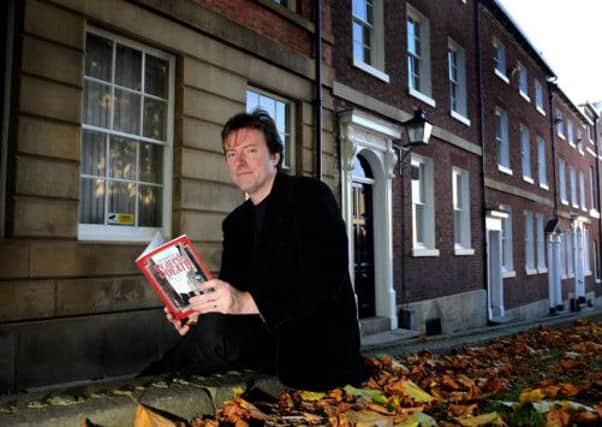Haunted by the past


Three days before Christmas in 1855, a ghost story brought Charles Dickens to Sheffield. The 43-year-old author, brimming with what a local newspaper called “his genial manner and fine spirits”, stepped out on stage at the Mechanics’ Institution to find a full house waiting for him. After giving him “a hearty cheer”, they settled back to enjoy one of his celebrated readings of A Christmas Carol, his ghost-ridden morality tale.
“The audience was in every respect an excellent one,” the newspaper reported, “the front seats being occupied by many of the best families of the town and neighbourhood; and the other parts of the room crowded by persons of great respectability, including not a few of our most intelligent working men.”
Advertisement
Hide AdAdvertisement
Hide AdAt the end of the reading, the Mayor presented Dickens with – this being Sheffield – a range of cutlery, including a pair of fish carvers, everyone cheered again, and Dickens left on the overnight mail train to London en route to Paris.
Author Dr David Clarke – a man, as we shall see, with an intergalactic dimension – has unearthed this footnote of Yorkshire literary history while researching his latest book, which, aptly enough, is about ghost stories. Just nine months before Dickens came, Clarke has discovered, the city was gripped by a spectral event that gives the book its name: Scared to Death. A labourer’s wife claimed to have seen a ghost – a lady in white – in a tenement house in the city centre. The woman died shortly afterwards and her death certificate recorded she died “in a fit believed to have been brought on by fright”.
Lured by the pulling-power of the supernatural, a 300-strong crowd gathered outside the supposedly haunted tenement, broke windows, stole roof lead, and uprooted flagstones in the cellar. Before long, street battles with the police broke out. All this as a result of an event that, looked at rationally, may have been a mere figment of the woman’s imagination.
As David Clarke and I sit in a café round the corner from the site of the incident, I wonder whether he himself – after compiling this bumper collection of Victorian ghost stories from Sheffield – actually believes in ghosts?
Advertisement
Hide AdAdvertisement
Hide Ad“I tend to sit on the fence,” he says. “What does it matter what I think? What interests me is what leads people to believe in them.” He doesn’t, he says, believe in the restless souls of dead people, but does believe in what MR James, author of some of the most disturbingly evocative ghost stories, called “sequestered places” where “curious creatures” lurk.
“I’ve been in places where there’s been a really strange atmosphere,” says Clarke, singling out the crypt at Lastingham parish church on the southern fringes of the North York Moors. “It was really weird, a feeling of a presence there; I wanted to get out quickly. Was that to do with the supernatural, or was it the sensation of being in a crypt, or because I knew other people had felt the same? People say seeing is believing, but I think what we believe, we see.”
There’s a hint there of Clarke’s streak of academic detachment: appropriate for a folklore historian and journalism lecturer at Sheffield Hallam University. It’s coupled with a scepticism nurtured by 30 years of investigating unexplained phenomena; notably Unidentified Flying Objects. As one of Britain’s leading researchers on the subject, he often appears on television when reports of flying saucers hover into the news and is a consultant to the National Archives, for whom he has written a book about the Ministry of Defence’s files of UFO sightings.
When we meet, he is just back from Scotland, after researching the Loch Ness Monster legend for another forthcoming book. “It’s UFO-logy in a pond,” he says. “There’s no evidence that the ‘monster’ exists, but why kill it off when it’s so good for tourism in Scotland?”
Advertisement
Hide AdAdvertisement
Hide AdWhy indeed? Superstitions make excellent popular entertainment. Ghost tours, sleepovers in haunted houses, ... abandon common sense and get that flesh creeping. As for seances...
“What fascinates me about the Victorian period is the element of spiritualism,” says Clarke. “People made the most bizarre claims about ectoplasm, but even hard-headed rational scientists refused to accept the evidence when it was shown to be false, because they were so wedded to their faith in the spirits.
“People won’t accept that some stories are made up. Just look at crop circles. When they first started appearing, people said it was aliens doing it. It turned out that it was two old blokes who created them. People couldn’t accept that the circles were made by humans.”
The ghosts, ghouls and goblins who loom through Scared to Death have been well-researched from newspaper reports and imaginatively illustrated. There are stories of devilish footprints in the snow and the Gabriel Hounds, howling “harbingers of calamity”.
Advertisement
Hide AdAdvertisement
Hide Ad“The book has been 30 years in the making,” says Clarke. “My inspiration was my grandmother who used to tell me ghost stories about Spring-Heeled Jack.” This ubiquitous bogeyman (famously also seen in Hull and Wakefield in the 1870s), boasted horns, blazing eyes and a whiff of sulphur. “Hundreds of people supposedly saw him, but there’s not a single named person quoted. It became one of the great urban legends of the Victorian period. People get obsessed with these things.”
Dr David Clarke will be discussing Scared to Death (ACM Retro, £12.95) on Hallowe’en (October 31) at Sheffield’s Upper Chapel, Norfolk Street, as part of the city’s Off the Shelf festival. 0114 273 4400, www.offtheshelf.org.uk